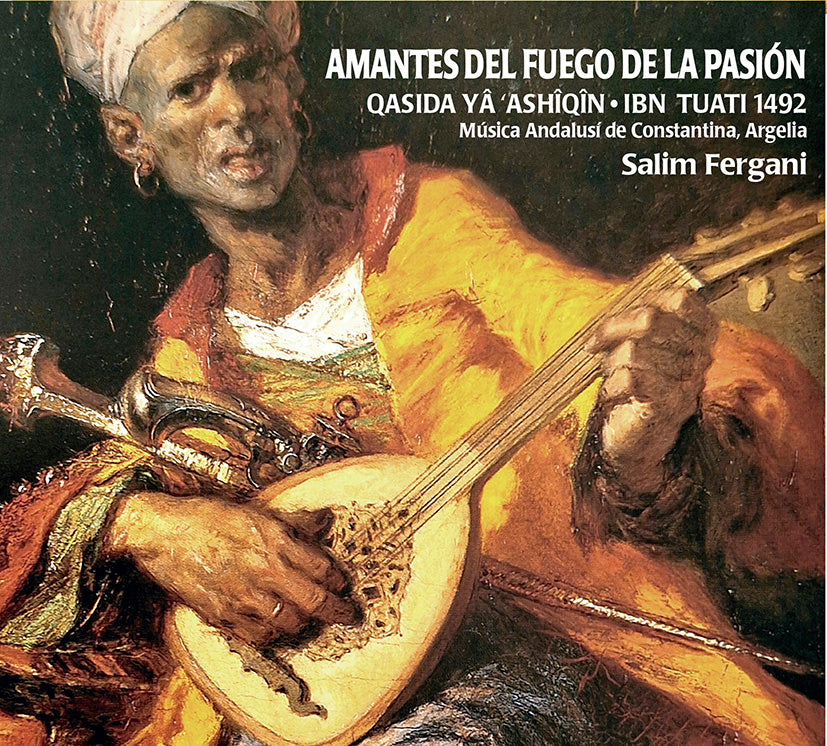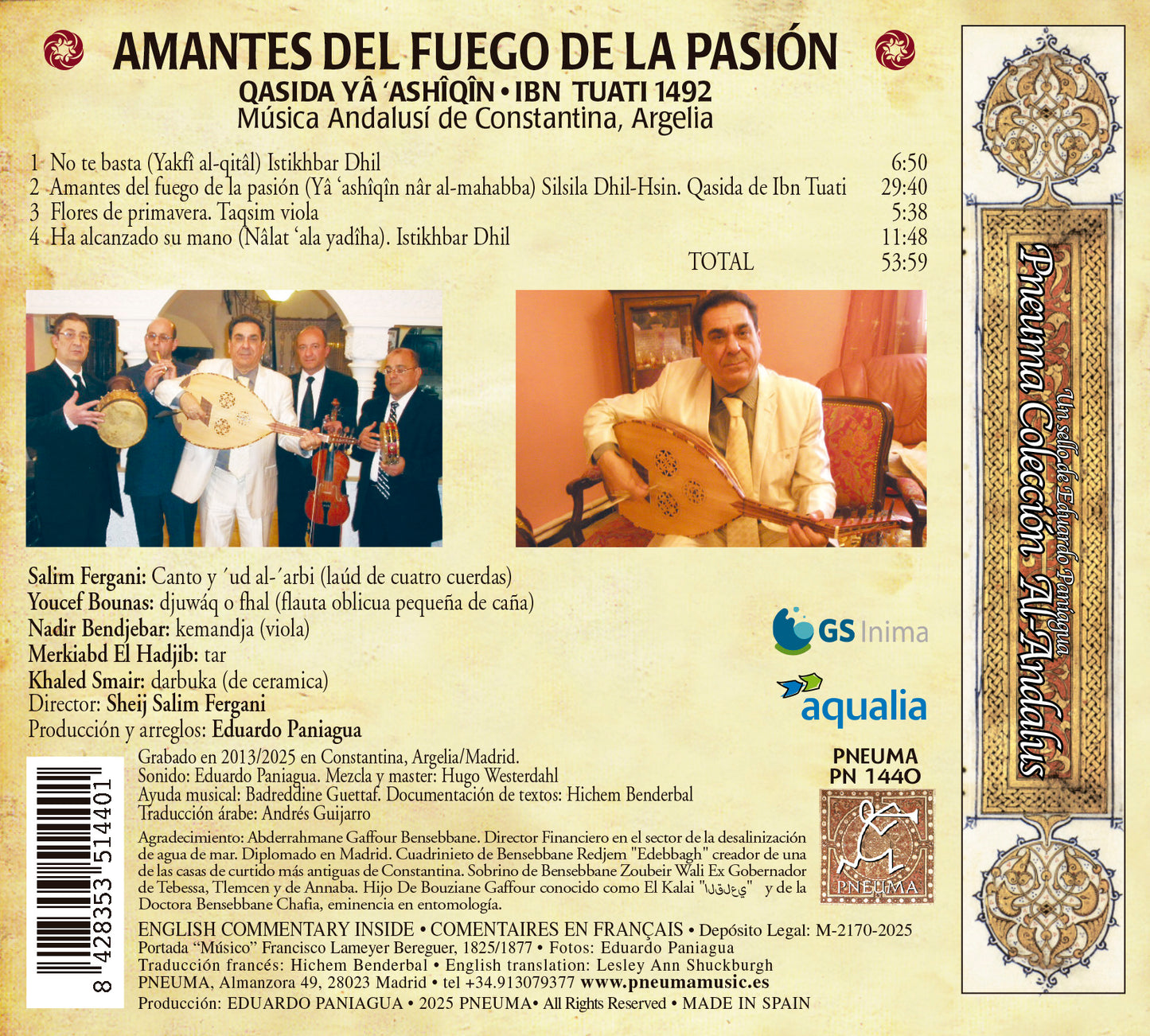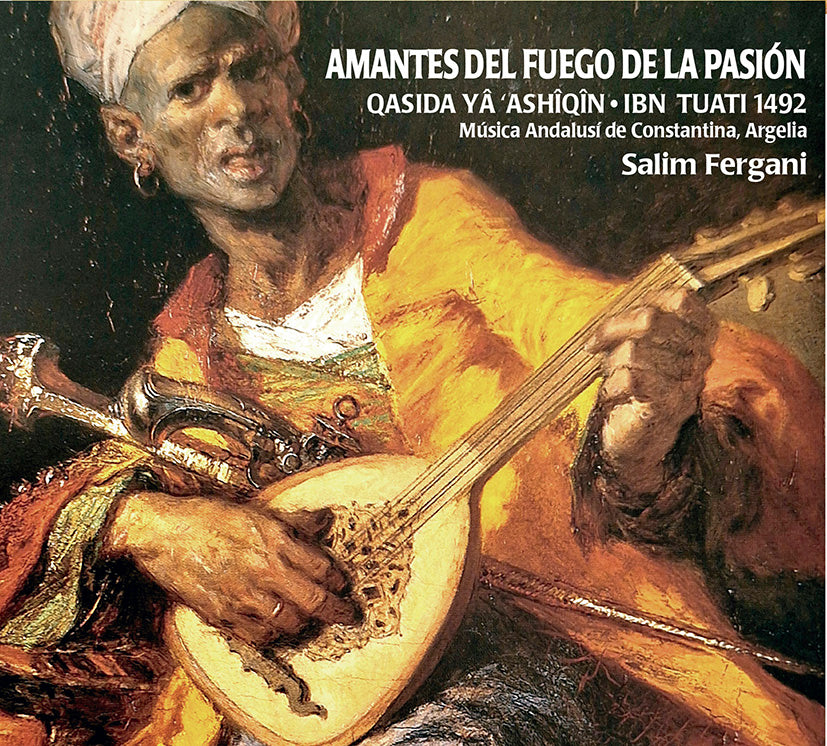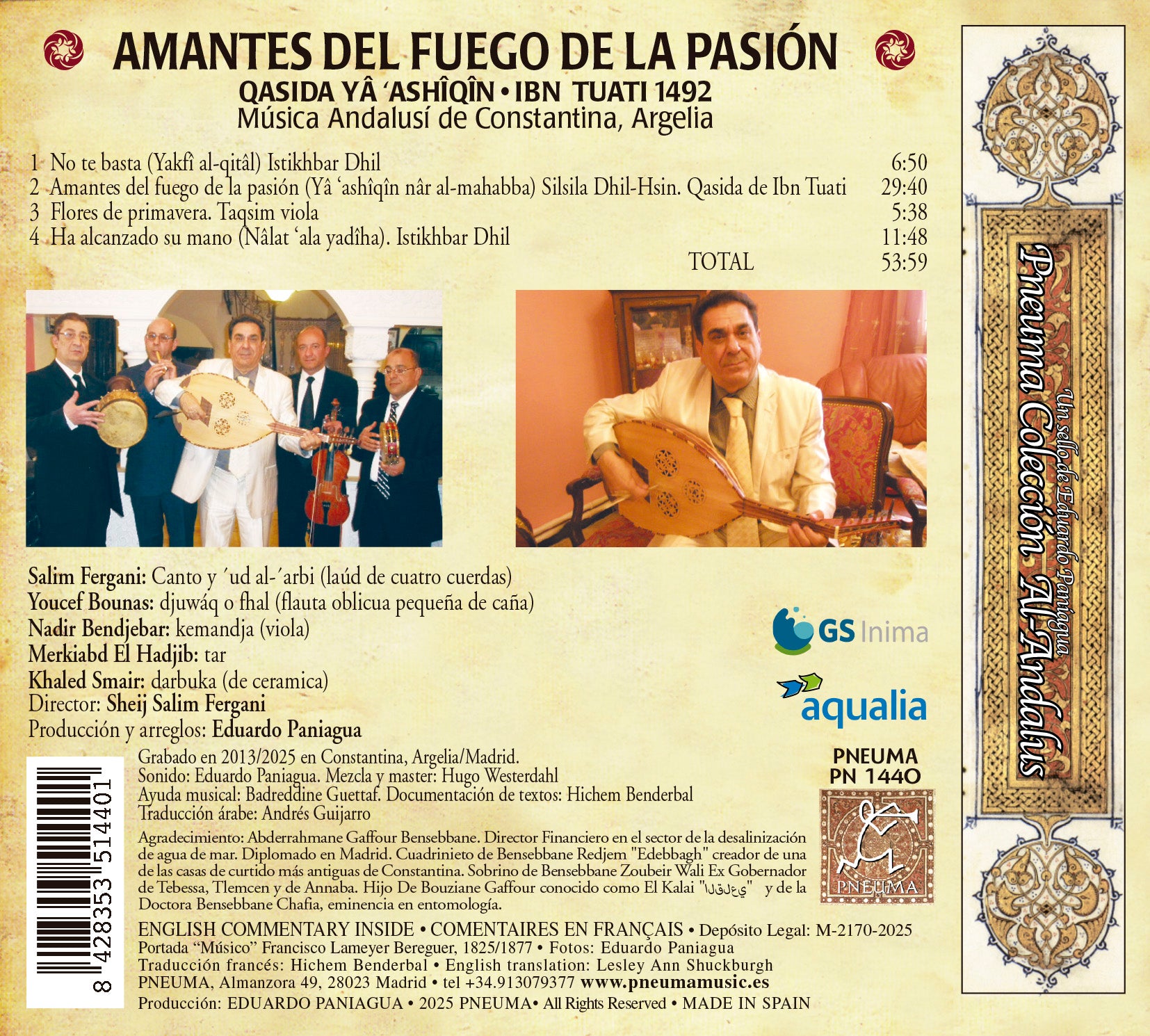pneumamusic
PN 1440 AMANTES DEL FUEGO DE LA PASIÓN. QASIDA YÁ ´ASHÍQÍN. IBN TUATI 1492. MÚSICA ANDALUSI DE CONSTANTINA, ARGELIA
PN 1440 AMANTES DEL FUEGO DE LA PASIÓN. QASIDA YÁ ´ASHÍQÍN. IBN TUATI 1492. MÚSICA ANDALUSI DE CONSTANTINA, ARGELIA
No se pudo cargar la disponibilidad de retiro
Índice
Índice
PN-144O AMANTES DEL FUEGO DE LA PASION • QASIDA YA ASHIQIN
QASIDA YÂ ‘ASHÎQÎN • IBN TUATI 1492• SALIM FERGANI
Música Andalusí de Constantina, Argelia
1 No te basta (Yakfî al-qitâl) Istikhbar Dhil 6:50
2 Amantes del fuego de la pasión (Yâ ‘ashîqîn nâr al-mahabba) Silsila Dhil-Hsin. Qasida de Ibn Tuati 29:40
3 Flores de primavera. Taqsim viola 5:38
4 Ha alcanzado su mano (Nâlat ‘ala yadîha). Istikhbar Dhil 11:48
TOTAL 53:59
Salim Fergani: Canto y ´ud al-´arbi (laúd de cuatro cuerdas)
Youcef Bounas: djuwáq o fhal (flauta oblicua pequeña de caña)
Nadir Bendjebar: kemandja (viola)
Merkiabd El Hadjib: tar
Khaled Smair: darbuka (de ceramica)
Director: Sheij Salim Fergani
Producción y arreglos: Eduardo Paniagua
Grabado en 2013/2025 en Constantina, Argelia/Madrid.
Sonido: Eduardo Paniagua. Mezcla y master: Hugo Westerdahl
Ayuda musical: Badreddine Guettaf. Documentación de textos: Hichem Benderbal
Traducción árabe: Andrés Guijarro
Agradecimiento: Abderrahmane Gaffour Bensebbane.
ENGLISH COMMENTARY INSIDE • COMENTAIRES EN FRANÇAIS • Depósito Legal: M-2170-2025
Portada “Músico” Francisco Lameyer Bereguer, 1825/1877 • Fotos: Eduardo Paniagua
Traducción francés: Hichem Benderbal • English translation: Lesley Ann Shuckburgh
PNEUMA, Almanzora 49, 28023 Madrid • tel +34.913079377 www.pneumamusic.es
Producción: EDUARDO PANIAGUA • 2025 PNEUMA• All Rights Reserved • MADE IN SPAIN
SALIM FERGANI
Salim Fergani proviene de una familia de artesanos y músicos. Su abuelo Hammou Fergani (1884-1972) fue maestro del hawzi. Salim nació justo antes de la trágica guerra de Argelia. En este duro medio social, desde los cinco años aprendió de sus antecesores los maravillosos secretos del maluf. Su padre El Hadj Mohammed Tahar Fergani fue su primer maestro y su tío Zonaoui le introdujo en la interpretación del laúd arbí. Con estos elementos Salim ha logrado una nueva sensibilidad de interpretación de los antiguos poemas ejecutados en las tradicionales melodías, consiguiendo su propio estilo y personalidad. Giras por todo el mundo le han dado una dimensión internacional y el apodo de “El trovador de Constantina”. Salim interpreta magistralmente todos los géneros tradicionales del canto: maluf, silsila, hawzi, mahdjúz,´rúbí, qadriya y zdjúl.
SALIM FERGANI
Salim Fergani comes from a family of craftsmen and musicians. His grandfather Hammou Fergani (1884-1972) was master of the hawzi. Salim was born just before the tragic war in Algeria. From the age of 5 he studied the marvellous secrets of the Maluf from his predecessors in this difficult social environment. His father El Hadj Mohammed Tahar Fergani was his first master and his uncle Zonaoui introduced him to the arbi lute. This background has helped Salim become more sensitive to the way the ancient poems are performed on the traditional melodies, creating his own style and personality. World tours have given him an international dimension and the nickname “The Troubadour of Constantine”.
Salim masters all the traditional genres of chant: maluf, silsila, hawzi, mahdjúz, ´rúbí, qadriya y zdjúl.
La presente grabación del sello Pneuma sobre el patrimonio musical argelino andalusí de la ciudad de Constantina está copatrocinada por las empresas Aqualia y GS Inima.
Descripción
Descripción
AMANTES DEL FUEGO DE LA PASIÓN
CONSTANTINA Y LA MÚSICA ANDALUSÍ
La música clásica árabe nace en Bagdad con el califa Mahdi Ibn al-Mansur en el año 775. Importada a España por Ziryab, esta música se independiza del mundo oriental y crea un nuevo estilo en al-Andalus al mezclarse con la música existente en la península ibérica. Es Ibn Báya (Avempace, m. 1138) el verdadero creador de la escuela arabigoandaluza, que se desarrolla hasta la caída de Granada en 1492 y se mantiene, con pérdidas y nuevas aportaciones, en todo el Magreb.
Constantina es una de las escuelas herederas de la música arabigoandaluza y tiene un singular repertorio debido a sus características históricas, a sus poetas autóctonos, a los maestros del siglo XIX y XX y a las cofradías religiosas que han conservado la moaxaja y el zéjel. Los turcos dejaron su impronta en la forma de la núba con la obertura llamada bashráf. La comunidad judía de Constantina, una de las más importantes en el norte de África, cultivó todo el repertorio arábigo andaluz, destacando en los géneros zdjúl y mahdjuz.
Constantina fue conquistada por los árabes y es con los fatimíes en el siglo IX cuando se comienza a citar su existencia. Con los ziríes y hammadíes, desde finales del siglo X a mitad del XII, fue cabeza de provincia. Durante los almorávides la ciudad no tiene especial relieve, pero con los hafsidas, a mediados del siglo XII, cobra importancia y desde mediados del XIII a mediados el XVI es la ciudad más importante de la zona, tras Túnez y Bugía. Cuando Bugía es tomada por los españoles en 1510, Constantina ostenta la capitalidad de toda la región. Túnez es conquistada por los turcos hacia 1553, y desde entonces Constantina no dependerá de Túnez sino de Argel, como capital de la Argelia turca. Desde 1563 el gobierno del caid o wali toma el nombre de bey, siendo elegido por el dey de Argel.
Hoy Constantina es la capital cultural del este de Argelia. Su patrimonio musical, trasmitido oralmente, es conocido y memorizado por la totalidad de los músicos tradicionales de la región, incluidas las ciudades de Annaba y Guelma. Este patrimonio se asienta en dos repertorios: el clásico y el popular, ambos con un papel esencial en la vida social e intelectual de Constantina. El repertorio clásico es denominado maluf o música arabigoandaluza. El origen y significado de la palabra maluf es discutido: obra de arte, composición, “ma´ulifa samá uhu” (lo que es costumbre escuchar). El maluf comprende la música culta, refinada, clásica, que se interpreta en un área geográfica comprendida por Túnez, Libia y la región de Constantina en Argelia. En Constantina la base del maluf es la núba. Se trata de una composición con una introducción instrumental y múltiples canciones encadenadas, basada en un solo modo musical y cinco movimientos rítmicos. El repertorio clásico del maluf se complementa con otras obras denominadas silsila (cadena) o madjmía, y el inqiláb o naclab, un tipo de núba pequeña. Las poesías de estas composiciones tienen la forma moaxaja (muwashshah) y zéjel, que tienen su origen en la península ibérica y la qasida clásica árabe. Normalmente anónimas, su temática versa sobre el amor, la ebriedad, la belleza de la mujer, la descripción de la naturaleza y los momentos del día y la noche.
La formación tradicional clásica, además del canto, tiene cinco instrumentos: ´ud al-´arbi (laúd de cuatro cuerdas dobles afinadas en quintas embrazadas), djuwáq o fhal (flauta oblicua pequeña de caña), kemandja (viola), darbuka (tambor en forma de copa) y tár (pandereta).
LA SILSILA
La silsila (cadena), es una sucesión encadenada de poemas, precedidos de una introducción sin ritmo llamada istikbar. El istikbar es un canto improvisado, hecho al aire y con el sentimiento del momento en el que se encuentra el cantor. Tiene cuatro partes: introducción, desarrollo, djwáb y cierre o qufla. Entre estas partes discurren respuestas instrumentales también improvisadas y que suelen estar ordenadas en esta secuencia: laúd, fhal y viola. A diferencia de la núba, la silsila se desarrolla en hasta cuatro modos musicales y un solo ritmo, a lo sumo dos.
LA QASIDA DE IBN TUATI
Dentro del repertorio de las Silsila de Constantina existe una rareza, la qasida de Ibn Tuati. Se trata de un largo poema, con 8 estrofas más una salida, en la que el autor se identifica al modo trovadoresco. “Ibn al-Tuwâti implora Tu gracia”.
El poema sigue ajustadamente el modelo de la qasida “Dam´i Yara-Fluyeron mis lágrimas”, atribuida al rey poeta sevillano Mu´tamid (1039-1095), tanto en la forma poética y musical como en el contenido, editado en Pneuma PN-1420. De su autor no sabemos mucho, tan solo que es un andalusí que se instaló en Tremecén después de la caída de Granada en 1492.
El protagonista de la historia (el príncipe), es seducido por unas jóvenes cantoras en un jardín delicioso. En un escenario bucólico, de flores, perfume, música y belleza, queda enamorado ante la elegida y acaba bendiciendo a Dios al pasar la noche con ella.
La qasida tiene una introducción para canto libre e instrumentos sin ritmo, un istkhjbar, sobre el que Salim Fergani ha elegido el texto (Yakfî al-qitâl) “¿No te basta lo que tus ojos han hecho de mi?”. Como final de la qasida hemos incluido un solo de viola y otro istkhjbar (Nâlat ‘ala yadîha) “Ha alcanzado su mano lo que mano alguna había alcanzado”.
Eduardo Paniagua
LOVERS OF THE FIRE OF PASSION. CONSTANTINE AND ANDALUSI MUSIC
Classical Arab music was born in Baghdad during the Caliphate of Mahdi Ibn al-Mansur in the year 775. Ziryab brought this music to Spain where it became established independently of the oriental world and a new style evolved as a result of the fusion with the music already present in the Iberian Peninsula. Ibn Baya (Avempace, d.1138) was the true creator of the Arab-Andalusian school, which developed until the fall of Granada in 1492 and is still found across the whole of the Maghreb in its original form, give or take a few losses and additions.
The Constantine school is one of the few that has inherited Arab-Andalusian music and boasts a special repertoire owing to its historical characteristics, local poets, the masters of the 19th and 20th centuries and the religious brotherhoods that have preserved the muwashshah and the zajel.
Conquered by the Arabs, Constantine is first mentioned in the 9th century at the time of the Fatimids. It was the provincial capital under the Zirids and the Hammadids between the end of the 10th and the middle of the 12th century. At the time of the Almoravids the town was of no special significance, but under the Hafsids, in the mid-12th century, it gained importance and from the mid-13th century to the mid-16th century it was the most important town in the area, after Tunis and Bejaia. When Bejaia was taken by the Spanish in 1510, Constantine became the capital of the whole region. Tunisia was conquered by the Turks in about 1553 and Constantine ceased to be part of Tunisia to become the capital of Turkish Algeria, under Algiers. From 1563 the Caid or Wali, who led the government, became known as the Bey, and was appointed by the Dey of Algiers.
Today, Constantine is the cultural capital of eastern Algeria. Its musical heritage, passed down through the oral tradition, is well known and has been memorised by all the traditional musicians in the region, including the towns of Annaba and Guelma. This heritage is based on two repertoires: the classical and the popular, both with an essential role in the social and intellectual life of Constantine.
The classical repertoire is known as the maluf or Arab-Andalusian music. There is debate about the origin and meaning of the word maluf. Work of art, composition, “ma’ulifa samá uhu” (what is usually listened to). The maluf includes the cultured, refined, classical music that is performed in the area including Tunisia, Libya and the Constantine region in Algeria.
In Constantine the nubah forms the structural base of the maluf . The nubah is a composition with an instrumental introduction and several connected vocal pieces, based on just one musical mode and five rhythmic movements. The classical repertoire of the maluf is complemented by other works known as the silsila (chain) or madjmia and the inqilab or naclab, a shorter version of the nubah. The poems used for lyrics in these compositions are in the muwashshah and zajel form that originate in the Iberian Peninsula. Normally anonymous, they are usually about love, inebriation, female beauty, the description of nature and the times of the day and night.
In addition to chant, the traditional classical formation has 5 instruments, the ´ud al-´arbi (a four-course lute tuned in “embraced” fifths), djuwáq or fhal (small oblique reed flute), kemandja (viola), darbuka (drum in the shape of a goblet) and tar (tambourine).
THE SILSILA
The silsila (or chain) is a succession of linked poems, preceded by an istikbar. The istikbar is a spontaneous improvised chant that reflects the singer’s feelings at the time. It has four parts, a beginning, the development, djwab and an end or qufla. Between these parts come improvised instrumental responses, the lute playing first, then the fhal and then the viola.
THE QASIDA BY IBN TUATI
The Constantine Silsila repertoire contains a rare piece, namely the qasida by Ibn Tuati. In this long poem, with 8 stanzas and an envoy or exit, the author identifies himself in the troubadour style “Ibn al-Tuwâti implores your grace”. The poem is closely modelled, both in poetic and musical form and in content, on the qasida, "Dam'i Yara-My tears flowed", attributed to the Sevillian poet-king Mu'tamid (1039-1095), edited in Pneuma PN-1420. We do not know much about its author, except that he was an Andalusi who settled in Tlemcen after the fall of Granada in 1492.The hero of the story (the prince), is seduced by some girls singing in a delightful garden. In a bucolic setting of flowers, perfume, music and beauty, he falls in love with his chosen one and blesses God when he spends the night with her.
The qasida has an introduction for free singing and instruments without a rhythm section, an istkhjbar, on which Salim Fergani has chosen the text (Yakfî al-qitâl) "Is it not enough for you what your eyes have made of me?". At the end of the qasida we have included a viola solo and another istkhjbar (Nâlat 'ala yadîha): "His hand has reached what no hand has ever reached".
AMOREUX DU FEU DE LA PASSION. CONSTANTINE ET DE LA MUSIQUE ANDALOUSI
La musique arabe classique est née vers 775 à Baghdad, sous le règne du Khalife Mahdi Ibn al-Mansur. Ziryab l’introduit en Espagne, où, sous l’influence de la musique existante dans la péninsule ibérique, elle acquit indépendance envers le monde oriental et s’établit en al-Andalus comme un genre musical nouveau. Ibn Bajja (dit Avempace, décédé vers 1138) fut le véritable créateur de l’école arabo-andalouse, qui se développa jusqu’à la chute de Grenade en 1492, et qui se maintient, avec pertes et nouveautés, dans tout le Maghreb.
Constantine est une des écoles héritières de la musique arabo-andalouse, ayant un répertoire singulier dû à ses traits historiques, et grâce à ses poètes autochtones, dont Ibn al-Jaluf (XVe siècle), les maîtres du XIXe et du XXe, et les confréries religieuses qui ont conservé la muwashshah et le zadjal.
Constantine fut conquise par les arabes et ce fut au IXe siècle, avec la dynastie Fatimide, quand son existence commença d’être signalée. Sous le gouvernement des dynasties Ziride et Hammadite, dès la fin du Xe siècle jusqu’à la moitié du XIIe siècle, elle fut capitale de province. Sous les Almoravides, la ville ne brilla pas spécialement; cependant, avec la dynastie des Hafcides, elle acquit prépondérance, et dès la moitié du XIIe siècle jusqu’à la moitié du XVIe elle a été la ville la plus importante de la région, après Tunis et Bejaïa. Quand les espagnols conquirent Bejaïa en 1510, Constantine devint la capitale de toute la zone. Les Turcs conquirent la Tunisie vers 1553, et dès lors Constantine cessa de dépendre de Tunis et se soumit à Alger, comme capital de l’Algérie turque. Dès 1563 le gouvernement caïd ou wali prit le nom de bey, élu par le dey d’Alger. Constantine est la capitale culturelle de l’Est algérien. Tous les musiciens traditionnels de la région, comprenant les villes de Annaba et Guelma, connaissent son patrimoine musical, transmis par tradition orale, qu’ils gardent dans leur mémoire. Ce patrimoine se fonde sur deux répertoires: le répertoire classique et le répertoire populaire, tous deux jouant un rôle essentiel dans la vie sociale et intellectuelle de Constantine.
Le répertoire classique s’appelle malouf ou musique araboandalouse. L’origine et la signification du terme maluf demeure incertain: oeuvre d’art, composition, “ma´ulifa samá uhu” (“ce que l’on écoute conforme à la tradition”). Le maluf comprend la musique culte, raffinée, classique, interprétée dans une région géographique comportant la Tunisie, la Libye et la région de Constantine à Algérie.
À Constantine, le maluf se fonde sur la nouba. Il s’agit d’une composition avec une introduction instrumentale et des nombreuses chansons enchaînées, fondée sur un seul mode musical et cinq mouvements rythmiques. Le répertoire classique maluf a pour complement d’autres ouvrages nommés silsila ou madjmía, et le inqiláb ou niqlab, un genre de núba plus courte. Les poésies de ces compositions ont pour forme la moaxaja
(muwashshah) et le zadjal, tous deux originaires de la péninsule ibérique. Normalment anonymes, elles chantent pour la plupart l’amour, l’ivresse, la beauté de la femme, la description de la nature et l’arrivée du jour ou de la nuit. La formation traditionnelle classique utilise, à part le chant, cinq instruments: ud al-´arbi (luth à quatre cordes doubles accordé en quintes successives), djuwáq ou fhal (petite flûte oblique en roseau), kemandja (viole), darbuka (tambour en forme de coupe) et tár (tambourin)
LA QASIDA DE IBN TUATI
Le répertoire de Constantin Silsila contient une pièce rare, à savoir la qasida d'Ibn Tuati. Dans ce long poème, comportant 8 strophes et un envoyé ou une sortie, l'auteur s'identifie dans le style troubadour « Ibn al-Tuwâti implore votre grâce ». Le poème est étroitement calqué, tant dans la forme poétique et musicale que dans le contenu, sur la qasida, «Dam'i Yara-Mes larmes ont coulé», attribuée au roi-poète sévillan Mu'tamid (1039-1095), publiè dans Pneuma PN-1420. On ne sait pas grand chose de son auteur, si ce n'est qu'il s'agit d'un Andalou installé à Tlemcen après la chute de Grenade en 1492. Le héros du récit (le prince), est séduit par des jeunes filles qui chantent dans un jardin délicieux. Dans un décor bucolique de fleurs, de parfum, de musique et de beauté, il tombe amoureux de son élue et bénit Dieu lorsqu'il passe la nuit avec elle.
La qasida comporte une introduction pour le chant libre et les instruments sans section rythmique, un istkhjbar, sur lequel Salim Fergani a choisi le texte (Yakfî al-qitâl) «Arrêtes ce duel et libères les liens de ton captif». A la fin de la qasida nous avons inclus un solo d'alto et un autre istkhjbar (Nâlat 'ala yadîha): «Sa main tatouée».
La qasida contient une introduction représentée par un chant libre et des instruments sans rythme, un Istikhbar, sur le Quel le Maitre Salim Fergani à choisi le texte ( yakfi-al-qital) : " c'est n'est pas suffisant pour toi, ce que tes yeux ont fait de moi?" A la fin de la Qassida, nous avons choisis, un solo avec du violon et un autre istikhbar (Nalat ala Yadiha) " sa main à décroché ce que aucune autre n'a réussit à faire”
Compartir


-
Envío gratis en pedidos mayores a 50 €.
Entrega en 5-7 días laborables para pedidos en España, en el caso de envíos fuera de España el tiempo de envío podría ser algo mayor.
-
Todo el trabajo de Pneuma Music se ha realizado en España.
Música medieval española inédita hasta el momento. Sus discos, con formato Digipack de cubierta de cartón y libreto interior (bilingüe + idioma original), quieren acercarse a una obra de arte total.


